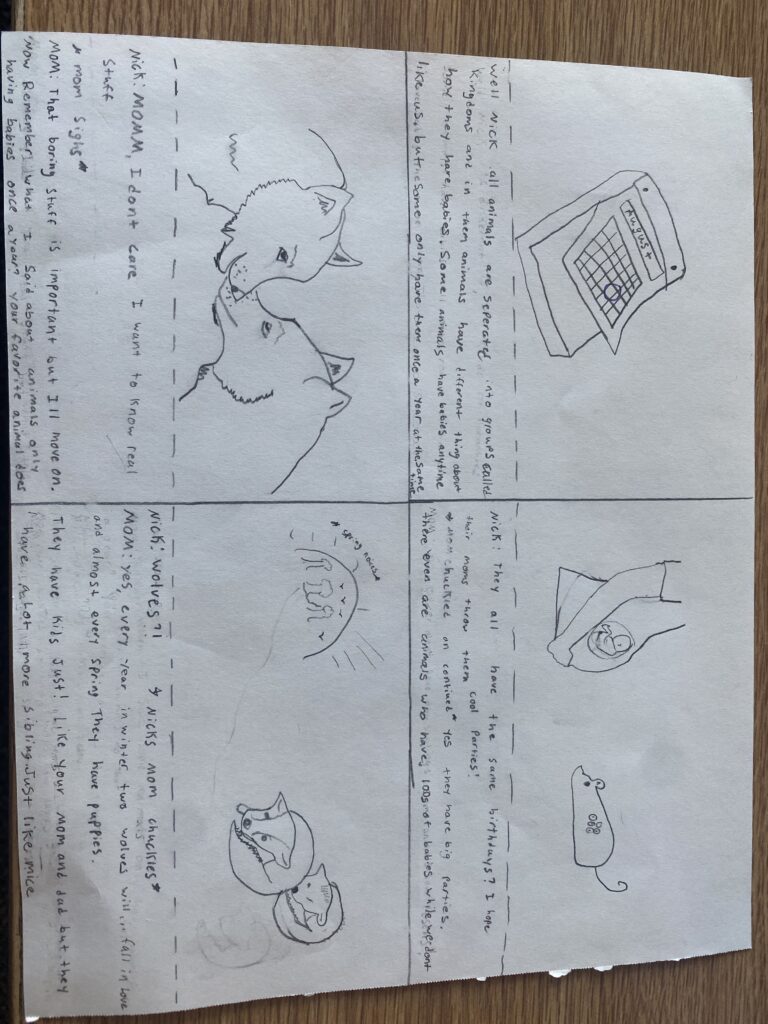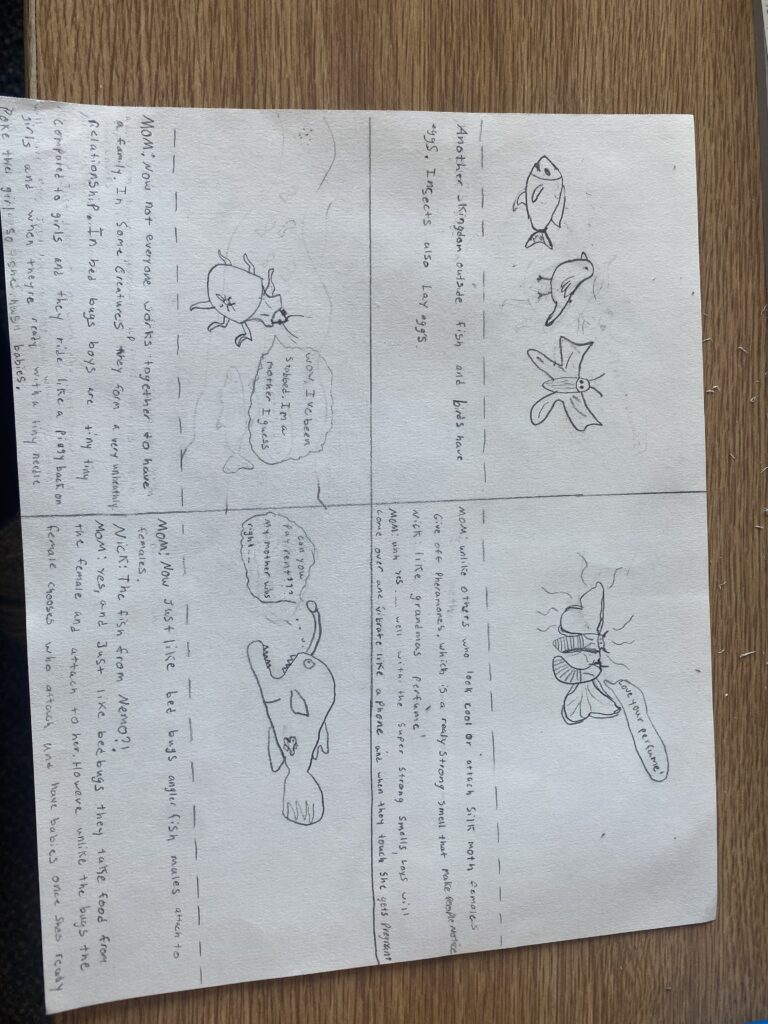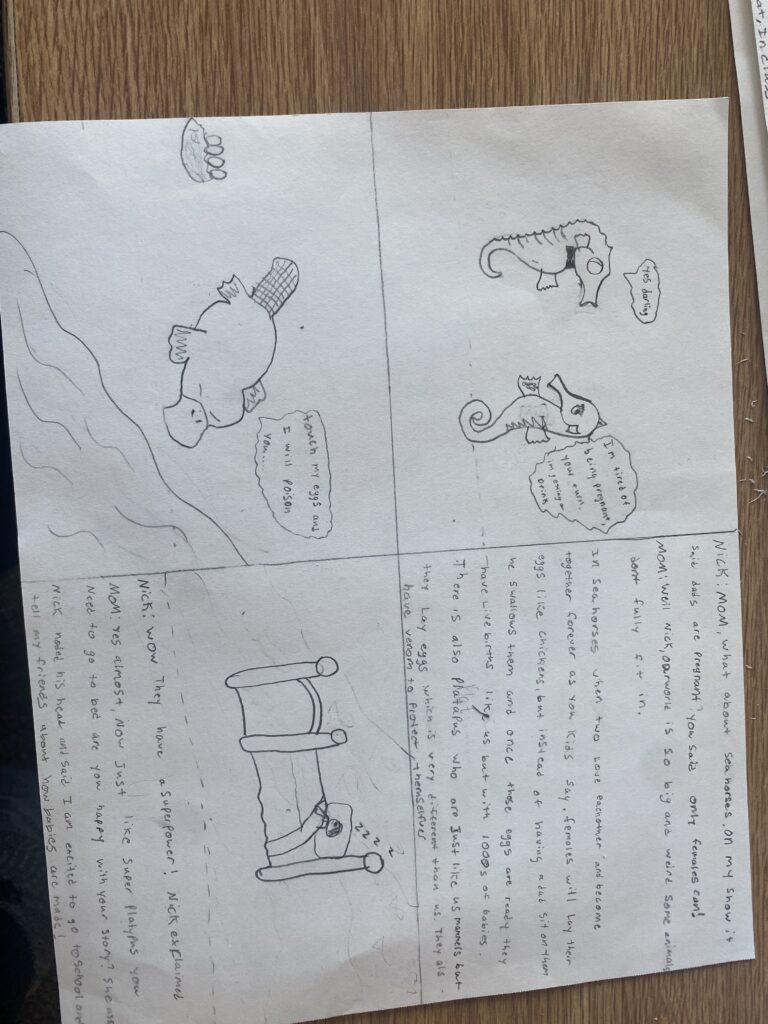




Steam project abstract:
The age-old question: how are babies made? It is a question parents dread and wish to push off as long as possible. However, this question is not as easy when you consider animals past humans. Almost every species has its own way of reproduction, while in different kingdoms they may overlap it still is very different. This project follows Nick and his mother learning about how different animals have children. In a adult comedy style children’s book Nick goes through the path learning about reproduction in seasonal vs year-round breeders and Iteropatry vs semelparity breeding. He learns how these are seen in animals he knows and ones he doesn’t. Nick even learns about the creatures that stunt scientists with their mixture of traits.
Essay portion
For my project I chose to do a children’s book, in class people joked about having a children’s book about an obviously not children appropriate subject and it brought a lot of laughter and group discussion. So, I decided to make a adult swim inspired book discussing ways animals reproduce and the difference between animals way of reproduction. In forms such as these which are very informal and more laughable, I feel like people will remember the topic because it is presented in a joking matter. It starts with a kid named nick asking his mother the age-old awkward question “how are babies made” Nick’s mother begins with the most common laughable answer of “when two people love each other” however Nick interrupts by wanting to know on a more scientific matter because in school he learned about birds having eggs compared to bears giving birth. Nicks answer represents an inquisitive side of nick that allows me to explain in more detail. This is where the story really begins, starting with topics we learned in class such as seasonal vs year-round breeders and Iteropatry vs semelparity breeding with a child level explanation of what they are. While explaining things can help nick learn, we all know children can learn better from examples. The book goes to Nick’s favorite animal, wolves. His mother talks about wolves being an example of seasonal breeders and Iteroparity. In simpler terms she explains in the late winter of January and February wolves will mate and in late spring females will give birth to multiple pups. However not all animals mate like humans. So, this book then moves onto bug births, in that section Nick’s mother discusses bed bugs and silk moths. These two insects provide an inside into other methods of having offspring as well as the use of pheromones. Afterwards to cover another section of animals she talks about aquatic animals such as fish whom lay eggs unlike mammals. That section covers more seasonal and semelparity breeders like salmon who swim away from their “homes” and go upriver purely for breeding. Finally, the book ends with the animals which are exceptions to some of the things nicks mother told him. Including platypus who lay eggs yet are mammals and even have venom unlike many mammals. I think this book relates to our course pretty well, In the course we learned that there are traits in each subject yet quite often there are always exceptions. In the beginning of the reproduction unit, we began with discussing some of the terms nick learned. (seasonal vs year-round breeders and Iteropatry vs semelparity) I think my project focuses on explaining those terms most especially. However, by explaining them in examples allows reader to understand these terms not just memorize them. The book even explains the different kingdoms of insect, mammals, and fish in a general breeding sense. While we did not go over a simple matter of broadly how these animals are separated in these kingdoms, I think my book provides explanations in a child’s level. While I don’t think this book should be presented to children. I think If this book could be longer, and I had more time to dive deeper into its concepts this could be an entertaining way to teach middle school- high school students these simple concepts.
Sources
Olympic National Park. (2019, July 22). The Salmon Life Cycle. National Parks Service. Retrieved from https://www.nps.gov/olym/learn/nature/the-salmon-life-cycle.htm
Wanule, D., & Balkhande, J. V. (2013). EFFECT OF TEMPERATURE ON REPRODUCTIVE AND EGG LAYING BEHAVIOR OF SILK MOTH BOMBYX MORI. Bioscience Discovery, 4(1), 15–19.
Saenz, V. L., Santangelo, R. G., Vargo, E. L., & Schal, C. (2014). Group living accelerates bed bug (Hemiptera: Cimicidae) development. Journal of Medical Entomology, 51(1), 293–295. https://doi.org/10.1603/me13080
Orzack, S. H., & Tuljapurkar, S. (1989). Population Dynamics in variable environments. vii. the demography and evolution of Iteroparity. The American Naturalist, 133(6), 901–923. https://doi.org/10.1086/284959
Braithwaite, R. W., & Lee, A. K. (1979). A mammalian example of semelparity. The American Naturalist, 113(1), 151–155. https://doi.org/10.1086/283372
Pietsch, T. W. (1976). Dimorphism, parasitism and sex: Reproductive Strategies Among Deepsea ceratioid anglerfishes. Copeia, 1976(4), 781. https://doi.org/10.2307/1443462
Holland, N., & Jackson, S. (2002). Reproductive behaviour and food consumption associated with the captive breeding of platypus (Ornithorhynchus anatinus). Journal of Zoology, 256(3), 279-288. doi:10.1017/S0952836902000328
Mai, A. C. G., & Velasco, G. (2011). Population dynamics and reproduction of wild longsnout seahorsehippocampus reidi. Journal of the Marine Biological Association of the United Kingdom, 92(2), 421–427. https://doi.org/10.1017/s0025315411001494
LINCOLN, G. A., & SHORT, R. V. (1980). Seasonal breeding: Nature’s contraceptive. Proceedings of the 1979 Laurentian Hormone Conference, 36, 1–52. https://doi.org/10.1016/b978-0-12-571136-4.50007-3
Peterson, R. O., Jacobs, A. K., Drummer, T. D., Mech, L. D., & Smith, D. W. (2002). Leadership behavior in relation to dominance and reproductive status in gray wolves, canis lupus. Canadian Journal of Zoology, 80(8), 1405–1412. https://doi.org/10.1139/z02-124

765559 1058You designed some decent points there. I looked on the net for any dilemma and located most individuals goes along with together along with your internet site. 696742